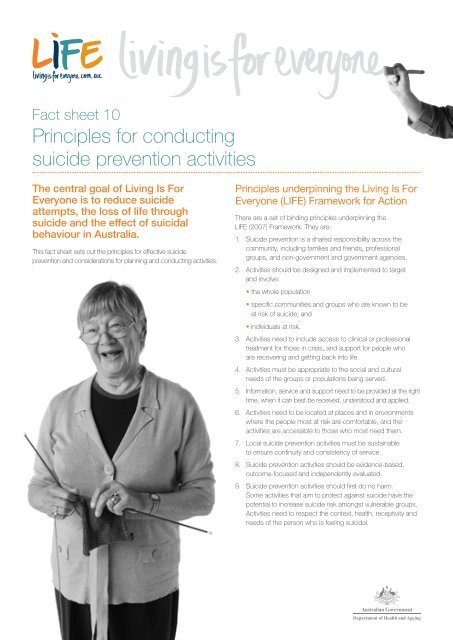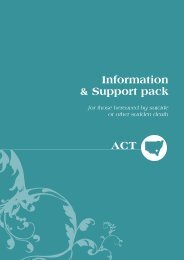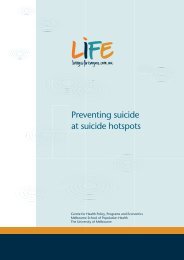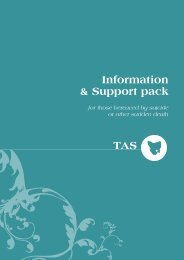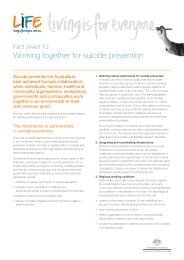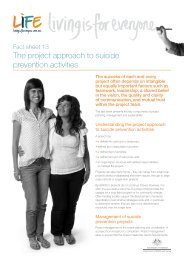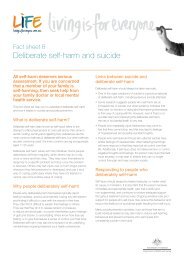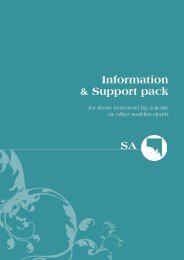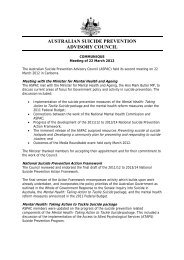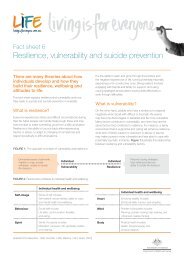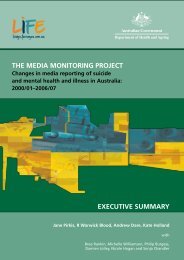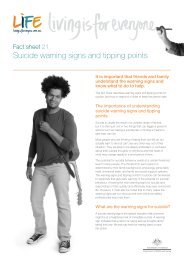Fact sheet 10: Principles for conducting suicide prevention activities
Fact sheet 10: Principles for conducting suicide prevention activities
Fact sheet 10: Principles for conducting suicide prevention activities
You also want an ePaper? Increase the reach of your titles
YUMPU automatically turns print PDFs into web optimized ePapers that Google loves.
<strong>Fact</strong> <strong>sheet</strong> <strong>10</strong><br />
<strong>Principles</strong> <strong>for</strong> <strong>conducting</strong><br />
<strong>suicide</strong> <strong>prevention</strong> <strong>activities</strong><br />
The central goal of Living Is For<br />
Everyone is to reduce <strong>suicide</strong><br />
attempts, the loss of life through<br />
<strong>suicide</strong> and the effect of suicidal<br />
behaviour in Australia.<br />
This fact <strong>sheet</strong> sets out the principles <strong>for</strong> effective <strong>suicide</strong><br />
<strong>prevention</strong> and considerations <strong>for</strong> planning and <strong>conducting</strong> <strong>activities</strong>.<br />
<strong>Principles</strong> underpinning the Living Is For<br />
Everyone (LIFE) Framework <strong>for</strong> Action<br />
There are a set of binding principles underpinning the<br />
LIFE (2007) Framework. They are:<br />
1. Suicide <strong>prevention</strong> is a shared responsibility across the<br />
community, including families and friends, professional<br />
groups, and non-government and government agencies.<br />
2. Activities should be designed and implemented to target<br />
and involve:<br />
• the whole population<br />
• specific communities and groups who are known to be<br />
at risk of <strong>suicide</strong>; and<br />
• individuals at risk.<br />
3. Activities need to include access to clinical or professional<br />
treatment <strong>for</strong> those in crisis, and support <strong>for</strong> people who<br />
are recovering and getting back into life.<br />
4. Activities must be appropriate to the social and cultural<br />
needs of the groups or populations being served.<br />
5. In<strong>for</strong>mation, service and support need to be provided at the right<br />
time, when it can best be received, understood and applied.<br />
6. Activities need to be located at places and in environments<br />
where the people most at risk are com<strong>for</strong>table, and the<br />
<strong>activities</strong> are accessible to those who most need them.<br />
7. Local <strong>suicide</strong> <strong>prevention</strong> <strong>activities</strong> must be sustainable<br />
to ensure continuity and consistency of service.<br />
8. Suicide <strong>prevention</strong> <strong>activities</strong> should be evidence-based,<br />
outcome-focused and independently evaluated.<br />
9. Suicide <strong>prevention</strong> <strong>activities</strong> should first do no harm.<br />
Some <strong>activities</strong> that aim to protect against <strong>suicide</strong> have the<br />
potential to increase <strong>suicide</strong> risk amongst vulnerable groups.<br />
Activities need to respect the context, health, receptivity and<br />
needs of the person who is feeling suicidal.
<strong>10</strong>. Activities need to be sensitive to the broader factors that may<br />
influence <strong>suicide</strong> risk – the many social, environmental, cultural<br />
and economic factors that contribute to quality of life and the<br />
opportunities life offers – and how these vary across different<br />
cultures, interest groups, individuals, families and communities.<br />
11. Services <strong>for</strong> people who are recognised as suicidal should<br />
reflect a multi-disciplinary approach and aim to provide a<br />
safe, secure and caring environment.<br />
Key considerations in implementing<br />
the LIFE Framework <strong>for</strong> Action<br />
In designing <strong>activities</strong>, actions and programs, the following<br />
must be taken into account:<br />
• The care and support provided to people at risk needs to<br />
match their unique needs. In particular, whether the path<br />
towards <strong>suicide</strong> is gradual and visible, or rapid with no<br />
outward sign of distress, specialised care needs to be<br />
available readily and rapidly when it is needed.<br />
• There should be a focus on:<br />
– reducing exposure to risk of <strong>suicide</strong>;<br />
– reducing access to the means of <strong>suicide</strong>;<br />
– improving protective factors;<br />
– providing individuals who are feeling suicidal with access<br />
to a range of support – from family and the community,<br />
the workplace, professional carers and health services;<br />
– identifying the individual’s particular needs and providing<br />
the right support, in the right place, at the right time;<br />
– improving community understanding of the needs of people<br />
with a mental illness, grieving, profoundly distressed or<br />
traumatised; and<br />
– education and in<strong>for</strong>mation <strong>for</strong> the immediate family, friends,<br />
social networks, work colleagues, and local health and<br />
community service professionals.<br />
• Place the health and wellbeing of the individual at the centre.<br />
This is essential to all <strong>suicide</strong> <strong>prevention</strong> planning and initiatives,<br />
and to creating appropriate pathways to care <strong>for</strong> <strong>suicide</strong><br />
<strong>prevention</strong>. This includes provision of community-based safety<br />
nets and services to support people in their transition between<br />
care providers and back into the community. The likelihood of<br />
<strong>suicide</strong> can increase significantly after a person is discharged<br />
from care. For instance, the risk of <strong>suicide</strong> increases by around<br />
200 times <strong>for</strong> patients (both men and women) after discharge<br />
from inpatient clinical care.<br />
• A key element of effective <strong>suicide</strong> <strong>prevention</strong> is also the provision<br />
of a coordinated response by all relevant individuals and services.<br />
This includes the concept of integrated pathways to care <strong>for</strong><br />
individuals. If an integrated system is in place, it does not matter<br />
where the search <strong>for</strong> help starts, a person should be able to move<br />
easily, smoothly and rapidly to the service that is best able to<br />
attend to his or her needs.<br />
• Care, support and services should be provided in accordance<br />
with evidence of good practice, and the expected outcomes<br />
from each intervention needs to be clearly defined so its<br />
effectiveness can be evaluated.<br />
Suicide <strong>prevention</strong> <strong>activities</strong>, services and programs should<br />
address the following three types of interventions defined<br />
in the LIFE Framework:<br />
• Universal interventions aim to engage the whole of a population<br />
or populations to reduce access to means of <strong>suicide</strong>, reduce<br />
inappropriate media coverage of <strong>suicide</strong>, and to create stronger<br />
and more supportive families, schools and communities.<br />
• Selective interventions entail working with groups and<br />
communities who are identified as at risk to build resilience,<br />
strength and capacity, and an environment that promotes selfhelp<br />
and support. This might include, <strong>for</strong> instance, working with<br />
families of those who have taken their own life to respond to their<br />
grief, loss and elevated risk of <strong>suicide</strong>; or working with children<br />
who are survivors of child abuse to build strength and resilience.<br />
• Indicated interventions target people who are showing signs of<br />
<strong>suicide</strong> risk or present symptoms of an illness known to heighten<br />
the risk of <strong>suicide</strong> (eg severe depression). These people can be<br />
helped to manage their current situation by solving some of the<br />
problems that have caused the illness. Alternatively, referral can<br />
be given to doctors or psychologists. Family and community<br />
members can be educated to recognise those warning signs<br />
and take appropriate action to support people at risk.<br />
More in<strong>for</strong>mation<br />
• Living Is For Everyone (LIFE) – A Framework <strong>for</strong> Prevention<br />
of Suicide in Australia (2007). Commonwealth Department<br />
of Health and Ageing: Canberra.<br />
• Living Is For Everyone (LIFE) – Research and Evidence in<br />
Suicide Prevention (2007). Commonwealth Department<br />
of Health and Ageing: Canberra.<br />
• Mental health & well being – in<strong>for</strong>mation on the Australian<br />
Government’s role and contributions to mental health<br />
re<strong>for</strong>m <strong>activities</strong> in Australia: www.mentalhealth.gov.au<br />
The Australian Government Department of Health and Ageing has financially supported the production<br />
of this document. While every ef<strong>for</strong>t has been made to ensure that the in<strong>for</strong>mation contained is accurate<br />
and up-to-date at the time of publication, the department does not accept responsibility <strong>for</strong> any errors,<br />
omissions or inaccuracies. © Commonwealth of Australia 2007. This work is copyright. Apart from any<br />
use as permitted under the Copyright Act 1968, no part may be reproduced by any process without prior<br />
written permission from the Commonwealth. Requests and inquiries concerning reproduction and rights<br />
should be addressed to the Commonwealth Copyright Administration, Attorney-General’s Department,<br />
Robert Garran Offices, National Circuit, Barton ACT 2600 or posted at http://www.ag.gov.au/cca


